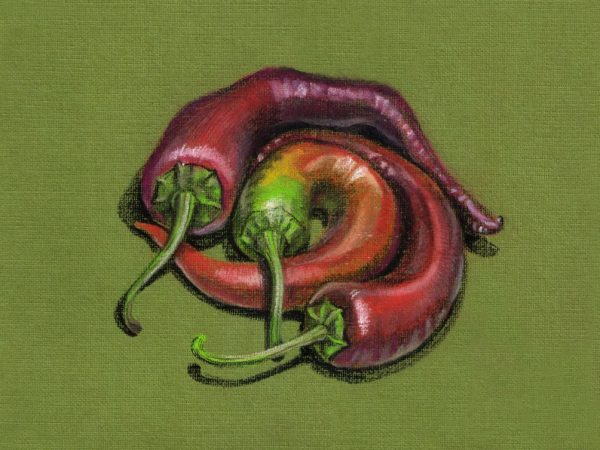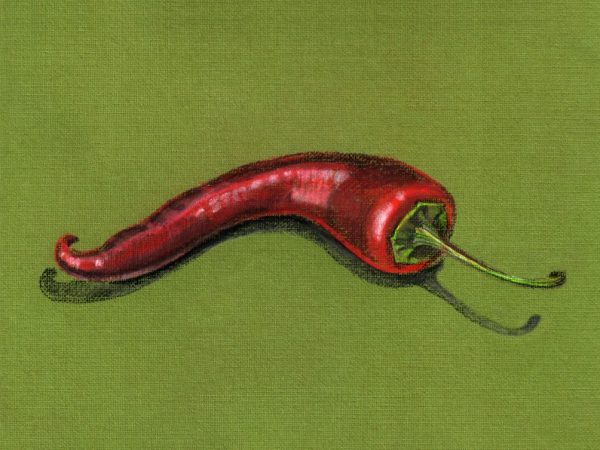Description of Pepper Horn
Bell pepper is one of the most popular and widespread. There are about 1500 thousand varieties of this vegetable. Among the variety of bell peppers, you can find spicy species. One of these is the ram's horn pepper. It is famous for its burning sharpness and large size, and it got its name due to its resemblance to the horns of a ram.

Pepper Lamb Horn
Characteristics of the variety
The ripening period for this variety is long (130-150 days), so hot pepper Ram's horn can be safely called a late vegetable. The description indicates that the plant is whimsical, requires constant transplants, baits, it is necessary not only to create conditions for growth, but also to protect it from pests.
Due to its aroma and pungent taste, this variety is highly prized in various cuisines and cultures. The vegetable is most popular in Asia, which is famous for its spicy dishes. In our countries, they eat it as a pickled appetizer or fresh.
Features of the bush
The characteristic says that an adult plant, with proper care, overcomes the 0.5 m mark in length. The bush has sprawling lush leaves and requires a lot of space. This should be taken into account when disembarking.
The bush has oblong leaves of a deep green color.
Description of the fetus
The fruits are bitter and stand out for their length, which can reach up to 50 cm in length. The diameter, on the other hand, is small, not exceeding 1.5 cm. Over time, it twists and takes the shape of a horn.
Weight does not exceed 30 grams. The number of fruits on one bush fully compensates for its low weight.
Growing pepper
This variety is extremely whimsical, therefore it is important to follow all the necessary rules for growing Lamb's horn pepper healthy and getting a large harvest. Consider the features of growing seedlings of such a pepper.
- Sowing seeds. It is necessary to sow the ram's horn pepper seeds 70 days before the start of planting work. The roots of the plant are very sensitive, therefore it is recommended to use separate containers. It is convenient to use disposable plastic cups. Seeds do not require pretreatment.
- Lighting. This is a light-loving plant, so the seedlings require lighting for at least 15 hours a day. It is necessary to purchase fluorescent lamps, because at the time of germination of crops, the daylight hours are short and insufficient for full development.
- Temperature. Since its homeland is a hot country, a rather high temperature is required for germination - 25 ° C, but when grown at lower temperatures (15-18 ° C), the plant will be stronger and harder.
- Watering. Irrigation is done as needed. The soil must be kept moist, drying out is unacceptable. Watering should be very careful so as not to damage the young stems with the pressure of water.
Landing in the ground
When the stem reaches 20 cm, you can plant. It is important to pay attention to the temperature of the soil, it should not fall below 15 ° C at night.Before planting, it is important to prepare the soil, it must be mulched with hay, mown grass, rotted foliage - so the soil will not dry out. The planting pattern is 50 x 50, the plant is spreadable and requires a lot of space.
The first fruits appear at the end of July. At the beginning of September, the plant must be removed from the ground with roots and placed in a greenhouse. Low temperatures are not tolerated by this vegetable and the root system dies.
Care advice

Peppers need warmth
Of course, we cannot control the weather conditions, but it is in our power to provide favorable conditions for the plant.
If the plant does not receive the necessary substances, you can use granules of slow-acting fertilizer, which will be enough for the entire season.
To grow a healthy plant, you also need to watch out for factors that negatively affect your health. These factors include:
- temperature drops, lead to freezing or drying of leaves;
- stagnant water is fraught with rotting of the root system and the death of the plant;
- water on the leaves - this vegetable reacts extremely negatively to the ingress of water on the foliage.
Diseases and pests
There are several of the most common diseases of the pepper in question.
- Late blight. It manifests itself in spots on the fruit and gray bloom on foliage and branches. It is quickly transmitted from one plant to another. In order to prevent the appearance of this disease, it is necessary to choose a well-lit place and follow the landing pattern. For prevention, tools such as Barrier and Barrier are suitable. For direct treatment, use a solution of calcium chloride (1%) in the treatment of the fruits themselves.
- Phytoplasmosis is characterized by complete cessation of growth and yellowing of foliage. To avoid disease, it is necessary to regularly weed and loosen the soil.
- Bronze is characterized by a pattern of yellow rings on the fruits of the plant. There is no cure for this disease, so sick bushes are destroyed, and healthy ones are treated with Fundazol.
Insects of various species, worms and larvae harm any plant, so their appearance should not be allowed.
- Aphid. She feeds on the sap of the plant, which is vital for him. To get rid of aphids, it is necessary to spray the plantings with insecticides; Thunder, Barguzin, Provotox are well suited.
- Spider mites affect plantings in the same way as aphids. A distinctive feature is a spider web on the branches. To fight, it is best to use Fufanon, Fosbetsd, or you can try folk remedies: medical alcohol, which should be used to wipe the stems, or a soap solution that is applied for a couple of hours and washed off with running water.
- Wireworm is a worm that damages the root system. To fight, it is best to use folk remedies, as chemicals can harm the roots. Effective means include: onion peels, which must be placed in a hole before planting or sprinkled with a thin layer of soil, in the same way you can use maid powder.
Conclusion
The ram's horn variety is quite spicy and famous for its appearance. However, the growing process is complex and requires effort. Therefore, only experienced gardeners will agree to grow Lamb Horn bitter pepper. For a strong and healthy plant, it is necessary to follow the planting rules and protect it from diseases and pests.


